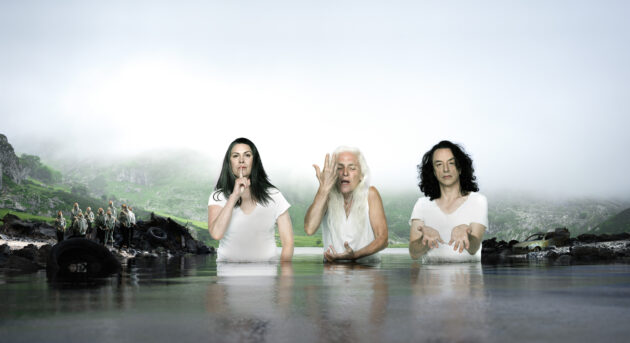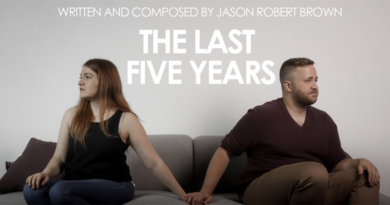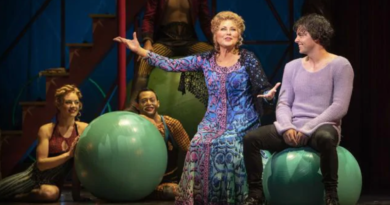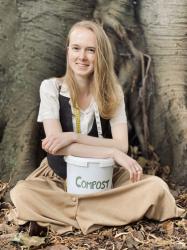The Composting Costumier talks The Last Season with Danielle Micich from Force Majeure
This interview took place between Boon Wurrung land of the Kulin Nation and Gadigal land. I acknowledge the Australian Aboriginal and Torres Strait Islander peoples as the first inhabitants and traditional custodians of the nation and pay my respects to their Elders past and present.
“Force Majeure brings theatre legends Paul Capsis, Olwen Fouéré and Pamela Rabe together with its new youth company for a truly epic new production” of The Last Season, presented as part of Sydney Festival at Carriageworks Jan 6-10 2021. “Using Vivaldi’s Four Seasons as a departure point for an intergenerational conversation exploring ageing, environmental destruction and speculative paths to human survival, The Last Season asks: How did we get here? What have we built? How can we continue?”
CC: Can you please briefly explain the concept of The Last Season?
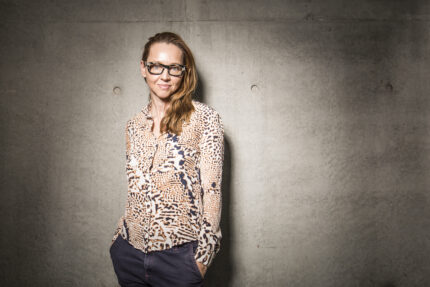
DM: Well, firstly, I should say that all works that I do are original works, so they’re built from the ground up and based around a particular artist that I’ve chosen specifically for the work. So it’s good to note that there’s no pre-existing script or classic play that I’m drawing from, it’s all drawn from a collaborative process.
The Last Season is really about taking a classic of sorts and pulling it apart in a way to examine our own behaviors and attitudes really, especially now that we’re having more and more conversations around how we’re contributing to climate change. For me, if I need to find a timeline to discuss the narrative around change, and what would be long enough to capture enough destruction and consumption we have done on the planet? So this is where Vivaldi’s classical music score, The Four Seasons came to me. It has been around [for] coming on 300 years [now] and that’s given me plenty of time to use… as a timeframe.
Vivaldi was trying to paint an aural picture of his environment 300 years ago, with this beautiful, dynamic classical music score The Four Seasons. Perhaps he could foresee the change of what was to come as he was just heading into the Industrial Revolution. There is something to be taken from the classical structure that has withstood the test of time. Lots of things come and go in our lives, I’m interested in what things we remember and hold onto as value, that have actually been substantial.
CC: The Last Season brings together Force Majeure’s Youth Company of 9 to 14 year-olds with theatre legends. What was the decision behind this and how has it fed into the piece?
DM: I love how you call them Theatre Legends, and they are, because when you’re talking about who’s in your work and you’re going “I’ve got Paul Capsis, Pamela Rabe and Olwen Fouéré” [they’re] huge huge individuals that have contributed [to this work]. They play the embodiment of the seasons.
I’ve created a cycle inside the work which needed counterpoint. So, one day, I attended a performance of a colleague of mine who was working with some young girls, and it just totally blew me away:
I walked out of this performance thinking I felt ten years younger and this feeling of hope came over me about the future: thinking if any of these young ladies in the future, [came into] a position of power, I would feel very [much] like everything is moving in the right direction.
Wow! There’s something to be said about young people and I haven’t seen for quite some time a significant contribution on the main stage working with young people.
So I ran a workshop at Catapult in Newcastle, and I found a young 12-year-old girl who I spent some time developing the initial idea with, to see if there was a conversation that I could be having with someone so young.
I found that I was not having these conversations with my own son but here in my work having one with this complete stranger, who speaks with their body and also has plenty to say about what she feels about the future.
So I brought her in, to work with her with Paul, and Pam and Olwen and it was remarkable: I thought “There is my counterpoint, and there is a conversation that is not being had with our younger generation with our older generation.” This needs to happen so we can all look and reflect and see what we can do to talk about the future. So along came a Youth Company that was needed to complete the work.
CC: So they were actually created for The Last Season?
DM: Yes, they weren’t in the original concept, they weren’t there at all. Earlier in my career, I ran a Youth Dance company in Perth for many years, and relied on those skills working with young people. Now, this Youth Company has become the bloodline through the work – They begin the work and they end the work. And they’re challenging the cycle and bringing change forward.
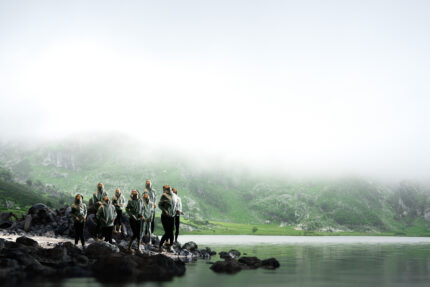
CC: Do you reckon that will continue with your company? The youth element?
DM: I had always been interested in putting a youth element into the company and I have been implementing something like this in the last two years through workshops. Is there a future? Absolutely! I’m already looking at all sorts of things, but each project’s different, and it just depends on what I’m tackling, but I feel like there is definitely a future for it.
CC: That’s so exciting. Yeah, society seems to be really recognising the importance of giving more agency to future generations, especially at a young age, can you speak a bit about this and what it’s like working with these kids in our current climate?
DM: First of all, I would say that anytime that you give agency and inclusion to a young person, that already gives someone confidence, they become articulate, they become open-minded and collaborative and that’s what we need in the future.
This has got nothing to do with dance: I know that I’m using movement as a vehicle, but actually, I’m trying to build better humans because of the way that we work. And so that methodology, when I work with young people, I work within what’s called the Youth Dance practice methodology, which is very different to say, young people dancing, or people learning a particular technique. It is about the art-form and the way we encourage people to contribute, think and execute. So for me I have always been an advocate for Youth Dance Practice. And when you create a strong community from the youth base, they learn that there are like-minded people out there that will be trying to progress.
CC: Yeah, absolutely!
Vivaldi’s Four Seasons is the departure point for this work. I can’t help thinking how Vivaldi worked and lived only a few decades before the Industrial Revolution and centuries before the Climate Crisis was even fathomable, let alone an everyday topic. What’s it like building a work that resonates with our contemporary concerns around such an iconic piece of music?
DM: It’s actually a really interesting discussion point, especially both with our adult and youth casts. I mean two years ago, we were having a conversation around humans being the modern day plague. And we’re now sitting in COVID. It is so fascinating, we were talking about [how] this could possibly happen. And it did.
Making this work, it’s really epic and it’s really rewarding when you’re looking at this particular piece of work. And when you know Vivaldi, this particular work was progressive, like it was set within a structure called Program Music (Note: a term not coined until the Romantic Period in the 1800s, while Vivaldi was composing in the early 1700s, ahead of his time structurally), which is made from sonnets that he had written about detailing the environment of his time. If you read the sonnets and listen to the music, you can actually follow it, you can follow the description, and go “oh that’s the birds here, this is now the festive season and you can hear [all] that coming through.
It’s been really interesting looking at this score and trying to find a way to bring attention to the need for change. Because we’re not sitting in the same environment anymore. Instead we’re having fires, drought and great environmental destruction around us.
So the question that we’re asking with this piece is: if we were to write a new sonnet today around the current season, what would it describe? I think something quite revealing.
At the same time, it’s really rewarding working with a bunch of different types of collaborators and performers on the same stage. The main thing I want to do is make sure that we are all listening to each other and we try to empower people, so actually we can see how resilient we are to move forward. Sometimes you feel like you can be overwhelmed and can’t move forward, but I want to talk about the progression of change.
CC: Yeah, not just stagnating. Since you’re working with theatre performers and you mentioned the sonnets: (I didn’t know there were sonnets that go with The Four Seasons) and you have spoken word in your pieces as well, just out of curiosity is that something that you’re bringing into this piece?
DM: We are not using the original sonnets but with our three iconic performers: Pamela Rabe has very formal text, Paul Capsis will have sung and spoken word and Olwen Fouéré uses language as a texture in a more abstract form. So, for ourselves, we’re using language in the way [to show the direction] that we feel our environment has taken as well – a form of disintegration.
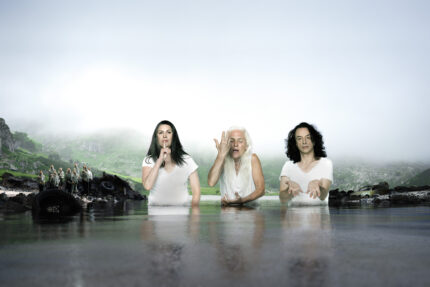
CC: As your company is presenting this ecologically topical performance, what climate or sustainability considerations are you taking into account in terms of your show’s impact?
DM: Well, you know, we are a very small company, very conscious of any footprint that we make. Just the smaller things like trying to make things paperless wherever we can: especially with COVID, because you’re having less and less personal exchange. But I would say in our productions that we’re trying to also do things like, recycle, and donate, when we’re not using something anymore, it won’t be thrown out. Like it’s not sustainable if we’re going to buy a whole bunch of [things] and just throw [them] out – what is it we can do with it [all]? Just looking at one of our most recent productions, we donated all our entire set and costumes, to schools that could use them and had another life which was really great.
CC: Yeah, and that’s really beneficial, also going towards educating other people as well.
DM: Yeah, because then they go “Where’s this from? Where’s that from” and you can show them the lifespan of something. But there was a point where one of those costumes that we do use in a site specific work, the materials weren’t so good, so we had to look at something way more durable that could last, a lot more, because we had two casts so we had to have two versions of the costume. And that means like, going well, it’s better [to have two versions] than having [to go through] a costume every single performance. So we had to reduce that by going “We don’t want to be making a costume every performance: that’s ridiculous”
It’s interesting, when you’re looking at the way that we work, one thing that I noticed that is different because of COVID is the fact that we can’t travel anymore and that now means that, going anywhere has been reduced and so our footprint, our carbon footprint has been reduced. One thing that we have been doing is we’ve really embraced this zoom rehearsal space and that means that we are now thinking about going into the future saying “maybe we shouldn’t be just flying someone in the second that we need to have a meeting”, because we all learnt how to engage online and I think that’s a really good contribution that we can do into the future about being more sustainable as a company.
CC: Yeah, absolutely. I find touring is really the biggest challenge for every company I’ve spoken to. And, yeah, this year, everyone learning zoom has also been a good solution to that.
So outside of your work, what is your connection to sustainability and the environment?
DM: My big contribution to all of this is that I’m vegetarian and I have been all my adult life and I’m very conscious about the impact of meat consumption on the planet. There’s a couple of other things that I feel like I can say I contribute to: I have a 20 000 L water tank on my property and it waters the streetscape and our property as well.
It’s kind of interesting, when you think of a community, it’s about not just looking after oneself, it’s looking after many and embracing that.
And we’re kind of going through this new thing where we want to make our home more sustainable, so we want to look into more renewable energy, which we haven’t done before. We’re going to shift our property over to renewable energy, and just really make ourselves living off our land in the middle of Sydney.
Also I sew, so what that means is anytime that something is either worn or torn or whatever, I don’t throw things out, I tend to have a big bag of things going “Oh I might just redo that t-shirt for tomorrow… I might just make a new bag out of this old dress”, so I’m constantly sewing. And that’s probably more of a creative outlet. But actually, it’s not [just that]. I don’t throw things out, I repurpose them. Like when I’m doing a project in the garage, or cleaning up something, I’m always being conscious.
Through this interview Danielle would like to support ANTaR: a national advocacy organisation dedicated specifically to the rights – and overcoming the disadvantage – of Aboriginal and Torres Strait Islander people.

